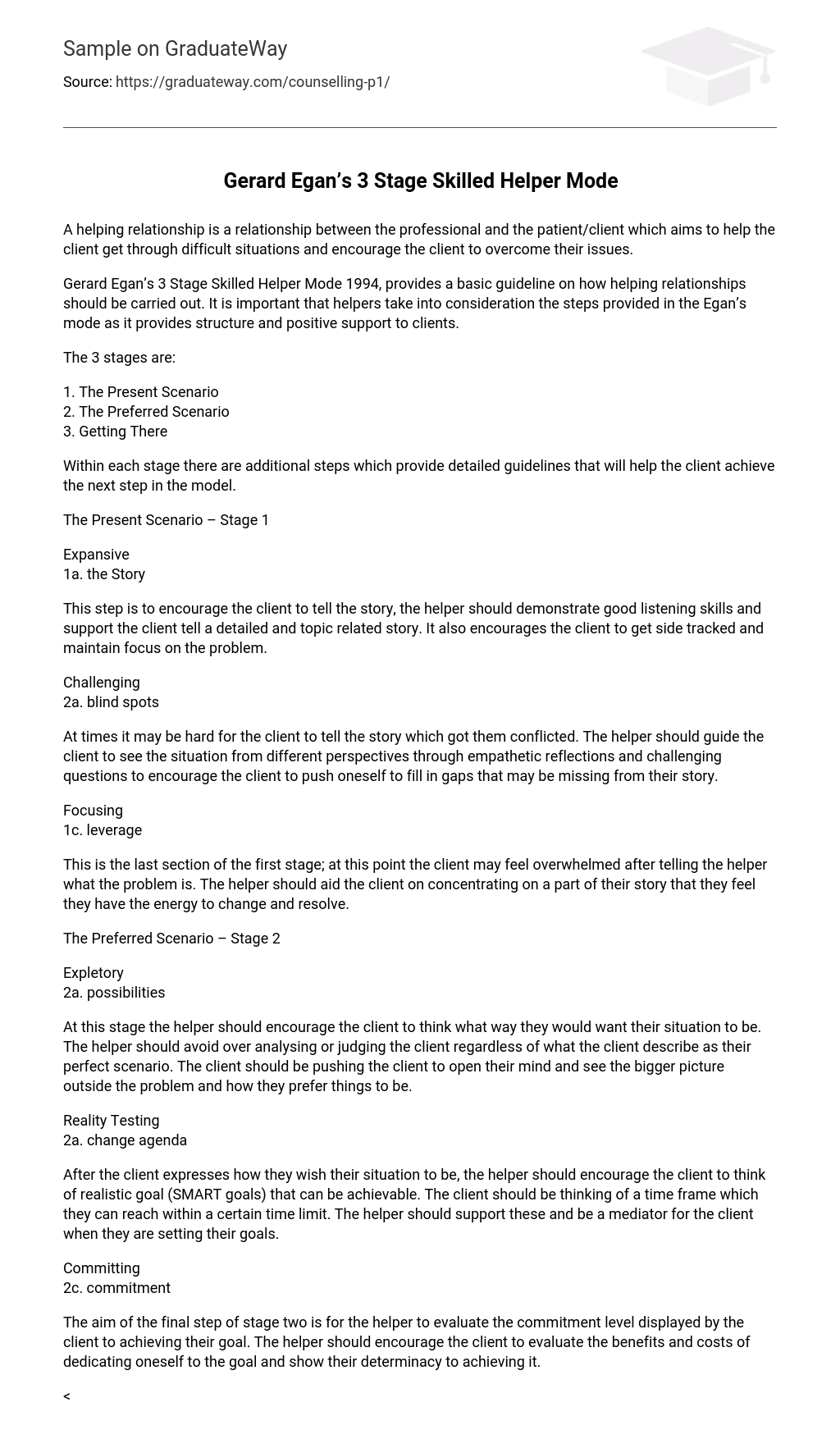A helping relationship is a relationship between the professional and the patient/client which aims to help the client get through difficult situations and encourage the client to overcome their issues.
Gerard Egan’s 3 Stage Skilled Helper Mode 1994, provides a basic guideline on how helping relationships should be carried out. It is important that helpers take into consideration the steps provided in the Egan’s mode as it provides structure and positive support to clients.
The 3 stages are:
1. The Present Scenario
2. The Preferred Scenario
3. Getting There
Within each stage there are additional steps which provide detailed guidelines that will help the client achieve the next step in the model.
The Present Scenario – Stage 1
Expansive
1a. the Story
This step is to encourage the client to tell the story, the helper should demonstrate good listening skills and support the client tell a detailed and topic related story. It also encourages the client to get side tracked and maintain focus on the problem.
Challenging
2a. blind spots
At times it may be hard for the client to tell the story which got them conflicted. The helper should guide the client to see the situation from different perspectives through empathetic reflections and challenging questions to encourage the client to push oneself to fill in gaps that may be missing from their story.
Focusing
1c. leverage
This is the last section of the first stage; at this point the client may feel overwhelmed after telling the helper what the problem is. The helper should aid the client on concentrating on a part of their story that they feel they have the energy to change and resolve.
The Preferred Scenario – Stage 2
Expletory
2a. possibilities
At this stage the helper should encourage the client to think what way they would want their situation to be. The helper should avoid over analysing or judging the client regardless of what the client describe as their perfect scenario. The client should be pushing the client to open their mind and see the bigger picture outside the problem and how they prefer things to be.
Reality Testing
2a. change agenda
After the client expresses how they wish their situation to be, the helper should encourage the client to think of realistic goal (SMART goals) that can be achievable. The client should be thinking of a time frame which they can reach within a certain time limit. The helper should support these and be a mediator for the client when they are setting their goals.
Committing
2c. commitment
The aim of the final step of stage two is for the helper to evaluate the commitment level displayed by the client to achieving their goal. The helper should encourage the client to evaluate the benefits and costs of dedicating oneself to the goal and show their determinacy to achieving it.
Getting There – Stage 3
Creative
3a. Possible Actions
The first step of stage 3 aims to encourage the client to brainstorm possible places, people, organisations; actions and attitudes that would them achieve their set goals. The helper should encourage and motivate the client to think widely on possible strategies to achieve their goal (101 ways to achieve the goal).
Selecting
3b. best fit strategies
After the brainstorm the client will be left with many strategies, the helper should set in to guide the client to select the best and most fitting strategy to achieve their desired goal. The helper should also guide the client to analyse the internal and external factors that may affect the way their strategy is carried out.
Moving Forward
3c. point
Egan’s Model final step, this aims to help the client plan their next steps. The plan of action should be broken down into small sections and the client should be confident and positive when explained their action plan to the helper. The helper should be encouraging the client to turn wishes into goals, but avoiding on pushing the client on creating goals that they have no desire of achieving.
To conclude Egan’s Model proves to be a concise and important part of a helping relationship as it provides helpers with a structure and guide on how to conduct sessions and how to track improvement from client when reaching a new stage.





